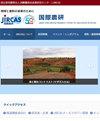Predicting Tectona grandis Suitability to Evaluate Potential Plantation Areas under Future Climate on Java, Indonesia
IF 0.5
4区 农林科学
Q4 AGRICULTURE, MULTIDISCIPLINARY
引用次数: 0
Abstract
Indonesia, mainly Java, is home to the second largest area of Tectona grandis (teak) plantations globally; however, despite their importance, little is known about the impact of climate change on this tree species. Here, species distribution models were developed using estimated site index values of T. grandis on Java as the response variable, with seven bioclimatic variables and three soil characteristics as predictor variables. Three statistical approaches—generalized linear, general additive, and random forest models—were examined. Two global climate models with two representative concentration pathways (2.6 and 8.5) and time periods (the 2050s and 2070s) were also used to compare the effect of predicted future changes in the site index. Of the three models, random forest model showed the best fit, with precipitation as the important predictor of T. grandis growth followed by temperature. The model predicted that 12.6% of Java Island would experience an increase in climatic suitability, with northeast of Banten Province, northeast and northwest of Central Java Province, and northwest of East Java Province becoming the most suitable for T. grandis growth in both the 2050s and 2070s. These findings suggest that certain areas should be prioritized for the development of future T. grandis plantations on Java.预测未来气候条件下印尼爪哇岛大构造适宜性评价潜在人工林面积
印度尼西亚,主要是爪哇岛,是全球第二大柚木种植园的所在地;然而,尽管它们很重要,但人们对气候变化对这种树种的影响知之甚少。本文以爪哇大叶松立地指数为响应变量,以7个生物气候变量和3个土壤特征变量为预测变量,建立了物种分布模型。研究了三种统计方法——广义线性模型、一般加性模型和随机森林模型。还使用了两个具有代表性浓度路径(2.6和8.5)和时间段(2050年代和2070年代)的全球气候模式来比较站点指数预测的未来变化的影响。三种模型中,随机森林模型拟合效果最好,降水是大叶松生长的重要预测因子,其次是温度。该模型预测,12.6%的爪哇岛将经历气候适宜性的增加,其中万丹省东北部、中爪哇省东北部和西北部以及东爪哇省西北部在2050年代和2070年代将成为最适合大叶猴生长的地区。这些发现表明,在爪哇岛上,某些地区应优先发展大叶松人工林。
本文章由计算机程序翻译,如有差异,请以英文原文为准。
求助全文
约1分钟内获得全文
求助全文
来源期刊
CiteScore
1.00
自引率
25.00%
发文量
42
审稿时长
>36 weeks
期刊介绍:
The Japan Agricultural Research Quarterly (JARQ) is a publication of the Japan International Research Center for Agricultural Sciences (JIRCAS), which provides readers overseas with the latest information on key achievements and developments in agricultural research in Japan, with the expectation that this information would contribute to the agricultural development of countries in tropical and subtropical regions.

 求助内容:
求助内容: 应助结果提醒方式:
应助结果提醒方式:


